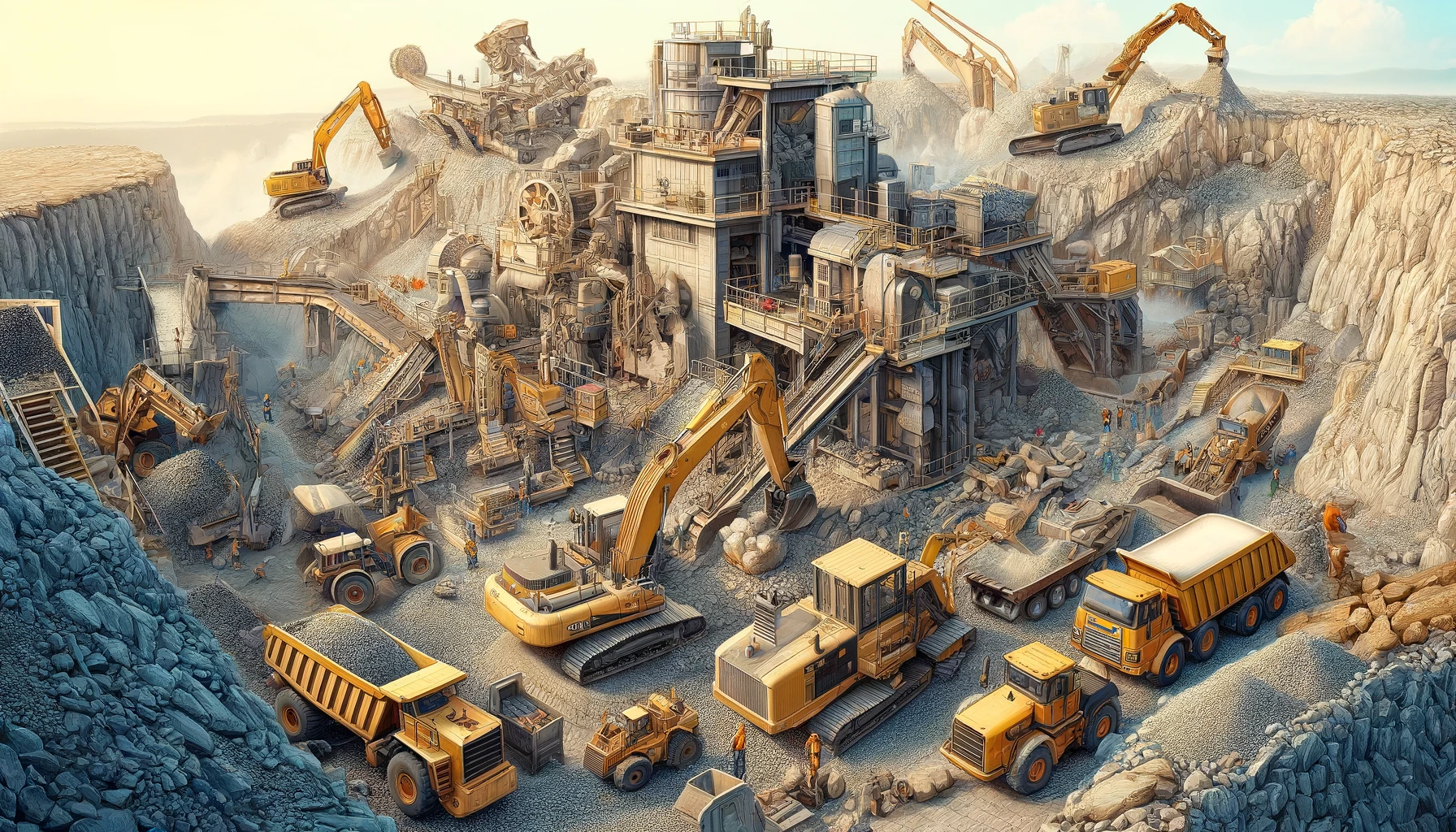
Stone quarries have been integral to human civilization for centuries, supplying the raw materials for buildings, monuments, and infrastructure. A stone quarry is a place where natural stone, such as granite, marble, limestone, and sandstone, is extracted from the earth. This process involves cutting, drilling, and blasting rock to access these valuable resources. Over time, the methods and tools used in quarrying have evolved from manual labor to sophisticated machinery, revolutionizing the industry by improving efficiency and safety.
In modern quarry operations, machinery is crucial. Advanced equipment has transformed the extraction and processing of stone, enabling larger volumes and greater precision. This has led to increased productivity, reduced labor costs, and enhanced safety for workers. In this guide, we will explore the various types of machinery used in stone quarries, providing you with a comprehensive understanding of their functions, advantages, and applications.
1. Drilling Machines
Rotary Drills
Rotary drills are essential for creating holes in rock for blasting and cutting. These machines use a rotating drill bit to penetrate the stone, making them ideal for drilling deep and precise holes. Rotary drills are known for their efficiency and ability to handle various rock types, making them a staple in quarry operations.
DTH (Down the Hole) Drills
DTH drills work by driving a hammer into the rock at the bottom of the drill hole, providing more direct and powerful drilling. This type of drill is especially useful for hard rock formations and deep drilling projects. DTH drills are valued for their accuracy and ability to operate in challenging conditions.
2. Blasting Machines
Primary Crushers
Primary crushers are used to break down large stones into smaller, manageable pieces. Common types include jaw crushers and gyratory crushers. Jaw crushers use compressive force to crush the stone between two rigid surfaces, while gyratory crushers use a gyrating cone to crush the stone. These machines are essential for the initial stage of stone processing.
Secondary Crushers
Secondary crushers further reduce the size of stone after it has been processed by primary crushers. Common types include cone crushers and impact crushers. Cone crushers use a rotating cone to crush the stone against a stationary surface, while impact crushers use high-speed impact to break down the stone. These machines ensure that the stone is finely crushed and ready for further processing or use.
3. Cutting Machines
Wire Saws
Wire saws use a wire with diamond segments to cut through stone with precision and minimal waste. These machines are ideal for cutting large blocks of stone into slabs or other desired shapes. Wire saws are prized for their efficiency and ability to produce smooth, clean cuts.
Chain Saws
Chain saws for quarrying are large, industrial machines that use a chain with cutting teeth to slice through stone. These machines are effective for cutting through softer stones like limestone and sandstone. Chain saws offer flexibility and speed, making them a popular choice for many quarry operations.
4. Screening Equipment
Vibrating Screens
Vibrating screens are used to separate stone particles by size. They work by vibrating a screen with different sized openings, allowing smaller particles to pass through while larger ones remain on top. Vibrating screens are crucial for ensuring that the final product meets the desired specifications.
Trommel Screens
Trommel screens consist of a rotating cylindrical drum with holes of various sizes. As the drum rotates, stone particles are separated by size. Trommel screens are particularly useful for sorting and separating materials in a quarry, providing an efficient way to process large volumes of stone.
5. Conveying Systems
Belt Conveyors
Belt conveyors transport stone from one part of the quarry to another. They consist of a continuous belt that moves over rollers, carrying the stone along its length. Belt conveyors are efficient, cost-effective, and can handle large volumes of material, making them indispensable in quarry operations.
Screw Conveyors
Screw conveyors use a rotating helical screw blade to move stone through a tube or trough. These conveyors are suitable for moving smaller, granular materials and are often used in conjunction with other machinery. Screw conveyors are compact and versatile, providing a reliable solution for material handling in quarries.
6. Surface Miners
Overview of Surface Miners
Surface miners are advanced machines that cut, crush, and load stone in a single operation. These machines use a rotating drum with cutting tools to remove material from the quarry face. Surface miners are highly efficient, reducing the need for drilling and blasting and minimizing environmental impact. They are particularly useful for extracting minerals from hard rock formations.
Conclusion
Machinery plays a vital role in the efficiency and safety of stone quarry operations. From drilling and blasting to cutting and conveying, each type of machine has a specific function that contributes to the overall success of the quarrying process. By understanding the various types of machinery used in stone quarries, operators can make informed decisions, optimize their operations, and ensure that they are using the best tools for the job.
Whether you are new to the quarrying industry or looking to upgrade your equipment, this guide provides a comprehensive overview of the essential machinery that powers stone quarries. For further reading and expert consultation, feel free to explore additional resources and reach out with any questions.
Frequently Asked Questions (FAQ)
1. What is the purpose of drilling machines in stone quarries?
Drilling machines are used to create holes in rock for blasting and cutting. They help in the initial stage of quarrying by drilling precise and deep holes into the rock, which are then filled with explosives to break the rock into manageable pieces.
2. How do primary crushers differ from secondary crushers?
Primary crushers are used to break down large stones into smaller pieces at the initial stage of stone processing. Common types include jaw crushers and gyratory crushers. Secondary crushers further reduce the size of stone after it has been processed by primary crushers, using machines like cone crushers and impact crushers to achieve finer crushing.
3. What are wire saws and how are they used in stone quarries?
Wire saws use a wire embedded with diamond segments to cut through stone with high precision and minimal waste. They are ideal for cutting large blocks of stone into slabs or other specific shapes, providing smooth and clean cuts.
4. Why are vibrating screens important in quarry operations?
Vibrating screens are used to separate stone particles by size, ensuring that the final product meets the desired specifications. They work by vibrating a screen with different sized openings, allowing smaller particles to pass through while larger ones remain on top.
5. What are the advantages of using belt conveyors in quarries?
Belt conveyors are efficient and cost-effective for transporting stone from one part of the quarry to another. They can handle large volumes of material and provide a continuous, reliable method of moving stone, reducing the need for manual labor and increasing productivity.
6. How do surface miners work and what benefits do they offer?
Surface miners cut, crush, and load stone in a single operation using a rotating drum with cutting tools. They reduce the need for drilling and blasting, minimize environmental impact, and increase efficiency by combining multiple steps into one machine.
7. What factors should be considered when choosing quarry machinery?
When choosing quarry machinery, consider factors such as the type of stone being quarried, the scale of operations, the desired end product, and the specific tasks the machinery will perform. It’s also important to consider the machinery’s efficiency, maintenance requirements, and safety features.
8. What maintenance is required for quarry machines?
Regular maintenance is essential to keep quarry machines running efficiently and safely. This includes routine inspections, cleaning, lubrication, and replacement of worn parts. Following the manufacturer’s maintenance guidelines and scheduling regular check-ups can help prevent breakdowns and extend the lifespan of the machinery.
9. Are there eco-friendly options for quarry machinery?
Yes, there are eco-friendly options for quarry machinery that focus on reducing environmental impact. These machines are designed to be energy-efficient, produce fewer emissions, and minimize waste. Examples include electric or hybrid-powered machines and those with advanced dust suppression systems.
10. Where can I find more information or purchase quarry machinery?
For more information or to purchase quarry machinery, you can explore industry-specific websites, contact manufacturers and suppliers directly, or attend trade shows and industry events. Additionally, many online resources and forums provide reviews, comparisons, and expert advice on quarry machinery.



Leave a Reply